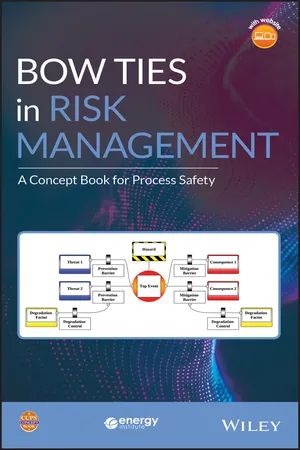
- English
- ePUB (mobile friendly)
- Available on iOS & Android
About This Book
AN AUTHORITATIVE GUIDE THAT EXPLAINS THE EFFECTIVENESS AND IMPLEMENTATION OF BOW TIE ANALYSIS, A QUALITATIVE RISK ASSESSMENT AND BARRIER MANAGEMENT METHODOLOGY
From a collaborative effort of the Center for Chemical Process Safety (CCPS) and the Energy Institute (EI) comes an invaluable book that puts the focus on a specific qualitative risk management methodology – bow tie barrier analysis. The book contains practical advice for conducting an effective bow tie analysis and offers guidance for creating bow tie diagrams for process safety and risk management. Bow Ties in Risk Management clearly shows how bow tie analysis and diagrams fit into an overall process safety and risk management framework.
Implementing the methods outlined in this book will improve the quality of bow tie analysis and bow tie diagrams across an organization and the industry. This important guide:
- Explains the proven concept of bow tie barrier analysis for the preventing and mitigation of incident pathways, especially related to major accidents
- Shows how to avoid common pitfalls and is filled with real-world examples
- Explains the practical application of the bow tie method throughout an organization
- Reveals how to treat human and organizational factors in a sound and practical manner
- Includes additional material available online
Although this book is written primarily for anyone involved with or responsible for managing process safety risks, this book is applicable to anyone using bow tie risk management practices in other safety and environmental or Enterprise Risk Management applications. It is designed for a wide audience, from beginners with little to no background in barrier management, to experienced professionals who may already be familiar with bow ties, their elements, the methodology, and their relation to risk management.
The missions of both the CCPS and EI include developing and disseminating knowledge, skills, and good practices to protect people, property and the environment by bringing the best knowledge and practices to industry, academia, governments and the public around the world through collective wisdom, tools, training and expertise. The CCPS has been at the forefront of documenting and sharing important process safety risk assessment methodologies for more than 30 years. The EI's Technical Work Program addresses the depth and breadth of the energy sector, from fuels and fuels distribution to health and safety, sustainability and the environment. The EI program provides cost-effective, value-adding knowledge on key current and future international issues affecting those in the energy sector.
Frequently asked questions
Information
1
INTRODUCTION
1.1 PURPOSE
1.2 SCOPE AND INTENDED AUDIENCE
- ensure consistent use of methodology and terminology;
- establish a valid approach to defining hazards, top events, threats, and consequences;
- establish criteria for barriers and degradation controls linked to degradation factors;
- identify common errors which may occur when constructing bow ties;
- provide a method to incorporate human and organizational factor issues in bow ties;
- provide guidance on how bow ties can be used for risk management purposes through the effective depiction of barriers;
- discuss basic and advanced uses of bow tie diagrams; and
- review an overall strategy for barrier management.
1.3 ORGANIZATION OF THIS CONCEPT BOOK
- Purpose and scope;
- Introduction to the bow tie concept;
- Linkage between bow ties, fault trees, and event trees.
- Define terminology and elements of the bow tie diagram;
- Illustrate robust and weak examples of bow tie elements;
- Define and discuss the types of barriers, including criteria for validity and quality.
- Discuss the process of bow tie development including their initial development in team workshops;
- Discuss common errors and quality checks during development of bow tie diagrams.
- Discuss how to include human and organizational factors in bow tie diagrams;
- Show how human factors can be addressed using a basic approach, but also introduce the concept of a multi-level bow tie which provides an extended analysis with greater utility, albeit with some complexity;
- Discuss metrics for human and organizational factors.
- Discuss common uses of bow tie tools in analyzing barriers and identifying safety critical elements and tasks.
- Discuss use of bow ties as part of a barrier management strategy utiliing a lifecycle approach;
- Discuss links between bow ties and management system elements (e.g., Management of Change, maintenance, training, audits).
- Discuss the application of bow ties as a communication tool and to help demonstrate ALARP;
- Illustrate how bow ties are used to aid in decision making for various activities in an organization and for risk management;
- Show how real-time bow ties can interface with an organization’s management system.
- Appendix A – Software Tools; provides a table listing various software tools available to develop bow ties and their capabilities;
- Appendix B – Case Study for a pipeline; provides an example of a full bow tie with an emphasis on technical threats;
- Appendix C – Case Study for Multi-Level Bow Ties; provides an example bow tie incorporating human and organizational factors and demonstrating the concept of multi-level bow ties.
1.4 INTRODUCTION TO THE BOW TIE CONCEPT

1.4.1 Reason’s Swiss Cheese, Models of Accident Causation and Bow Ties
Table of contents
- Cover
- Title page
- Copyright page
- Acronyms and Abbreviations
- Glossary
- Acknowledgments
- Online Materials Accompanying This Book
- Preface
- 1: Introduction
- 2: The Bow Tie Model
- 3: Bow Tie Development
- 4: Addressing Human Factors in Bow Tie Analysis
- 5: Primary Uses Of Bow Ties
- 6: Barrier Management Program
- 7: Additional Uses of Bow Ties
- Appendix A – Software Tools
- Appendix B – Case Study
- Appendix C – Multi-Level Bow Ties
- References
- Index
- Wiley end User License Agreement